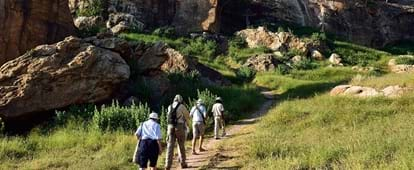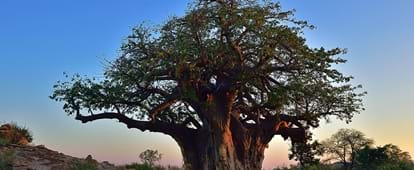By creating an account, I agree to the
Terms of service and Privacy policy
Choose your country and language:
Africa
Americas
Asia Pacific
Europe
TThe low sandstone hills at Mapungubwe National Park glow in the sun, anchored by giant baobabs that seem on the brink of breaking into dance.
Perhaps they are why people talk about the 'feel' of Mapungubwe being different to any other park. It has a distinctive spirit of place.
The area has been layered in a long and convoluted history, which may explain an unexpected feeling of connectivity. Its beauty convinced then-prime minister of South Africa, General Jan Smuts, to proclaim it as a national park in the 1930s, but it was deproclaimed by others a decade later. He loved this area, built a home here and imagined a megapark stretching across borders.
The defining image of this park today is the viewpoint where the Limpopo and Shashe rivers merge, where you can see Botswana and Zimbabwe from South Africa across the watery border.
Smuts' dream has finally come true. This area is now one of southern Africa's planned transfrontier parks and a World Heritage Site. The Great Limpopo Transfrontier Park will incorporate conservation areas in Mozambique, Zimbabwe and South Africa.
The wild animals of the park, including lions, elephants, rhino, leopard and wild dogs, already migrate back and forth to the protected areas within all 3 countries without a care for the human boundaries.
The glowing sandstone hills hold one more important secret for you. The level top of one of the hills called Mapungubwe was the centre of a remarkable African gold-trading civilisation, dating back more than 1 000 years.

AAfter a guided tour has fascinated, spend a little time atop Mapungubwe Hill among the waving grasses. You'll sense the peace that overlays its rich and almost incredible history.
Archaeological studies have shown that 1 000 years ago, ancient Mapungubwe was trading in gold and ivory with Arabia, India and China. As this ancient African kingdom became more hierarchical, the leaders moved to hilltops, ruling over commoners and craftspeople below. Mapungubwe Hill was one of the richest archaeological sites, yielding gold-leaf figurines (the most famous of which is the Mapungubwe golden rhino), beads and fragments of Chinese pottery.

TTravel tips & planning info
Who to contact
SA National Parks Reservations
Tel: +27 (0) 12 428 9111
Email: reservations@sanparks.org
Mapungubwe National Park
Tel: +27 (0)15 534 2014
How to get here
The nearest large domestic airport is at Polokwane, which is about 3 hours' drive away. You could also drive to Polokwane from Johannesburg, which takes about 3 hours. From Polokwane, head by car for Musina and then the R572 Pontdrif Road. All in all, it won't take you more than about 6 hours to drive from Johannesburg.
Best time to visit
Autumn through midwinter to early summer (April to September) are very pleasant. Mid-summer (November to February) can be uncomfortably hot.
Things to do
Book for a walking tour of Mapungubwe Hill at the central office within the park. Unguided walking is not permitted due to the large and dangerous game animals in the park.
You could see the famous wild dogs of nearby Venetia Limpopo Nature Reserve.
What to pack
Pack for the African bushveld: outdoor gear, jacket, big hat.
Related links

